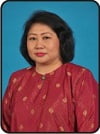Students’ Attitudes to Learning Mathematics with Technology at Rural Schools in Sabah, Malaysia
Abstract
ABSTRACT: The purpose of this study was to investigate students’ attitudes to learning Mathematics with Technology at rural Secondary Schools in Sabah, Malaysia. This study involved 17 Secondary rural and non-rural Secondary Schools in Sabah. A total of 613 Form 4, Form 2, and Form 1 students were randomly chosen as respondents. Descriptive and inferential statistics were used to analyze the collected data. The reliability of the instrument was analyzed by using the Statistical Packages for Social Sciences (SPSS) version 13.0 for Windows. Descriptive statistical analysis showed that only 13.0% of rural Secondary School students possessed positive attitude to learning Mathematics with Technology as compared to 21.5% of students from non-rural Secondary Schools. Results of independent sample t-test has indicated that there was a significant difference (t = -2.424, df = 543, p < 0.05) in attitudes to learning Mathematics with Technology between rural and non-rural school students. Students from non-rural Secondary Schools possessed higher Confidence with Technology compared to students from rural schools. Inferentional statistical analysis also showed that there was no significant difference in students’ attitudes to learning Mathematics with Technology based on gender, streaming, and level of schooling. Therefore, Mathematics teacher is the main factors in how technology is used in classroom. Finally, school administrators should encourage Mathematics teacher to use ICT (Information and Communication Technology) widely to enhance their teaching.
KEY WORD: Students’ attitudes, learning Mathematics with technology, rural Secondary Schools, and Mathematics teachers.



About the Authors: Chin Kin Eng, Crispina Gregory K Han, and Dr. Lay Yoon Fah are Lecturers at the School of Education and Social Development UMS (Malaysia University of Sabah), Jalan UMS, 88400 Kota Kinabalu, Sabah, Malaysia. They can be reached at: sportychin@yahoo.com, pieces.cris@yahoo.com, and layyoonfah@yahoo.com.my
How to cite this article? Eng, Chin Kin, Crispina Gregory K. Han & Lay Yoon Fah. (2011). “Students’ Attitudes to Learning Mathematics with Technology at Rural Schools in Sabah, Malaysia” in ATIKAN: Jurnal Kajian Pendidikan, Vol.1(2) Desember, pp.247-262. Bandung, Indonesia: Minda Masagi Press owned by ASPENSI in Bandung, ISSN 2088-1290.
Chronicle of the article: Accepted (October 22, 2011); Revised (November 26, 2011); and Published (December 15, 2011).
Full Text:
PDFReferences
Abidin, Y.Z. (2005). Cerita-cerita Motivasi Cemerlang Matematik. Pahang: Malindo Printers Sdn. Bhd.
Abu Saman, Norhasim, Y. Mazanah & Rose Alinda Alias. (1996). Pengajaran Bantuan Komputer. Kuala Lumpur: Dewan Bahasa dan Pustaka.
Barkatsas, A., K. Kasimatis & V. Gialamas. (2009). ”Learning Secondary Mathematics with Technology: Exploring the Complex Interrelationship between Students’ Attitudes, Engagement, Gender, and Achievement” in Computers & Education, 52, pp.562-570.
Blackett, N. & D.O. Tall. (1991). “Gender and Versatile Learning of Trigonometry Using Computer Software” in Proceeding of the International Group for the Psychology of Mathematics Education XV. Italy: Assisi, pp.144-151.
Brandt, D.S. (1997). Constructivism: Teaching for Understanding of the Internet. Dordrecht: Kluwer Academic Publishers.
Chong, Chee Keong, Sharaf Horani & Jacob Daniel. (2005). “A Study on the Use of ICT in Mathematics Teaching” in MOJIT: Malaysian Online Journal of Instructional Technology, 2(3), ISSN 1823-1144, pp.43-51.
Cockcroft, W.H. (1982). Mathematics Counts. London: HMSO.
Galbraith, P. & C. Haines. (1998). “Disentangling the Nexus: Attitudes to Mathematics and Technology in a Computer Learning Environment” in Educational Studies in Mathematics, 36, pp.275–290.
Gómez-Chacón, I.M. & C. Haines. (2008). “Students’ Attitudes to Mathematics and Technology: Comparative Study between the United Kingdom and Spain”. Paper presented at 11th International Congress on Mathematical Education.
Hannula, M.S. (2002). “Attitude towards Mathematics: Emotions, Expectations, and Values” in Educational Studies in Mathematics, 49, pp.25-46.
Henderson, R. & E. Landesman. (1992). “Mathematics and Middle School Students of Mexican Descent: The Effects of Thematically Integrated Instruction” in Tech. Rep. Research Report, No.2. Santa Cruz: National Center for Research on Cultural Diversity and Second Language Learning, University of California. Also available at: http://www.ncela.gwu.edu/pubs/ncrcdsll/rr5.htm [accessed in Kota Kinabalu, Sabah, Malaysia: 19 September 2011].
Jonanssen & Carr. (2000). “Mindtools: Affording Multiple Knowledge Representations for Learnings” in S.P. Lajoie [ed]. No More Walls, Vol.2. Hillsdale, NJ: Lawlence Erlbaum Associates, Inc., pp.165-196.
Kenneth. (1996). “Calculators in the Mathematics Curriculum: The Scope of Personal Computational Technology” in A.J. Bishop et al. [eds]. International Handbook of Mathematics Education, Part 1. Dordrecht: Kluwer Academic Publishers, pp.435-468.
López-Martio, G. & G. López. (2007). “Computer Support for Learning Mathematics: A Learning Environment Based on Recreational Learning Objects” in Computers & Education, 48, pp.618-641.
Monaghan, J. (2004). “Teachers’ Activities in Technology-Based Mathematics Lessons” in International Journal of Computers for Mathematical Learning, 9, pp.327-357.
Pierce, R., K. Stacey & A.N. Barkatsas. (2007). “A Scale for Monitoring Students’ Attitudes to Learning Mathematics with Technology” in Computers and Education, 48(2), pp.285-300.
Rosas, R. et al. (2003). “Beyond Nintendo: Design and Assessment of Educational Video Games for First and Second Grade Students” in Computers & Education, 40(1), pp.71-94.
Ruffell, M., J. Mason & B. Allen. (1998). “Studying Attitude to Mathematics” in Educational Studies in Mathematics, 35, pp.1-18.
Sidek Mohd Noah. (2002). Reka Bentuk Penyelidikan: Falsafah, Teori, dan Praktis. Serdang, Selangor: UPM [Universiti Putra Malaysia].
Simmons, M. (1993). The Effective Teaching of Mathematics. New York: Longman Publishing.
Suhardi, S. (1999). ”Drama Matematik: Puncak Harapan” in Jurnal Akademik Maktab Perguruan Ilmu Khas, Jilid XVII.
Temple, L. & H. Lips. (1989). “Gender Differences and Similarities in Attitudes towards Computers” in Computers in Human Behaviour, 5, pp.215-226.
Usun, S. (2004). “Undergraduate Students Attitudes on the Use of Computers in Education” in Educational Studies in Mathematics, 56, pp.125-135.
Vale, C. & G. Leder. (2004). “Student Views of Computer-Based Mathematics in the Middle Years: Does Gender Make a Difference?” in Educational Studies in Mathematics, 56, pp.287-312.
